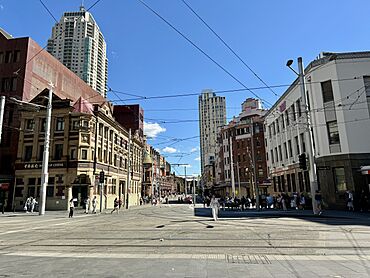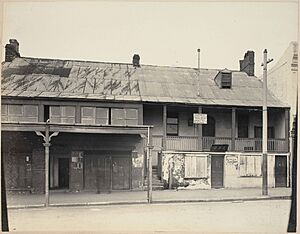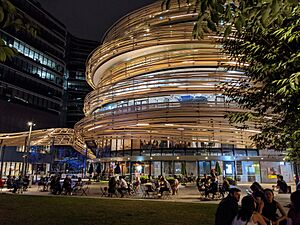Haymarket, New South Wales facts for kids
Quick facts for kids HaymarketSydney, New South Wales |
|||||||||||||||
|---|---|---|---|---|---|---|---|---|---|---|---|---|---|---|---|

The intersection between George Street and Hay Street
|
|||||||||||||||
| Postcode(s) | 2000 | ||||||||||||||
| Area | 0.4 km2 (0.2 sq mi) | ||||||||||||||
| LGA(s) | City of Sydney | ||||||||||||||
| State electorate(s) | Sydney | ||||||||||||||
| Federal Division(s) | Sydney | ||||||||||||||
|
|||||||||||||||
Haymarket is a lively inner-city suburb in Sydney, New South Wales, Australia. It sits at the southern edge of the main city center. Haymarket is famous for being home to much of Sydney's Chinatown and Thaitown. It also includes the area around Railway Square. This suburb is close to Darling Harbour and is surrounded by other suburbs like Ultimo, Chippendale, Surry Hills, and the Sydney CBD.
Contents
A Look Back: Haymarket's History
For many years, starting in the early 1900s, Haymarket was home to Sydney's big produce markets. This is where fruits, vegetables, and other goods were sold. In the 1980s, these markets moved to a new place called Flemington.
Today, a famous market called Paddy's Markets is still there. It's a fun place to find fresh food and lots of different items, like a big garage sale! The 'Market City' building is now on this spot. It has the markets, a tall apartment building called The Peak, and a modern shopping center. You can find food, shops, a cinema, and games there.
The outside walls of the original vegetable market, built in 1909, were saved and fixed up. They show a special old building style called Edwardian architecture. These walls were part of the first city markets. They were designed by city architect C. Broderick. The markets were located between Hay Street, Quay Street, and Thomas Street. They were built because the older Belmore Market was too far from Darling Harbour.
The new markets also included the Sydney City Markets building on Ultimo Road. This building was designed by George McRae and finished in 1910. There was also the Sydney Markets Bell Tower on Quay Street, built in 1911. The State Bank restored this bell tower in 1985. Today, the bell tower is part of the University of Technology Sydney.
By the 1920s, Sydney's "Chinatown" had moved to Haymarket. Before that, it was in areas like the Rocks and Market Street. Haymarket became a key place for the Chinese community. Many Chinese people lived here and in nearby areas like Surry Hills.
When the produce market moved to Flemington, and people started moving to other suburbs, Haymarket became less busy. So, the City of Sydney decided to make Haymarket a tourist-friendly Chinatown. In the 1980s, Dixon Street was made into a walking-only area. New buildings were designed to feel like an "authentic" Chinatown. This included building Chinese paifang-style gates with stone lions on Dixon Street. They also added other Chinese-style street decorations. Chinese restaurants were encouraged to open along Dixon Street. Even with many new people from different parts of Asia moving in, today's Chinatown is still a busy center for Asian restaurants and businesses.
The Capitol Theatre, a famous old theater built in 1928, is also located in Haymarket.
Special Places: Heritage Listings
Haymarket has several sites that are protected because of their history. These "heritage-listed" places include:
- 17 Little Pier Street: The Hydraulic Pump Station
- 181–187 Hay Street: 181–187 Hay Street (also known as the Corporation Building). This building is home to the 4A Centre for Contemporary Asian Art.
Who Lives Here: Population Facts
| Historical population | ||
|---|---|---|
| Year | Pop. | ±% |
| 2001 | 5,091 | — |
| 2006 | 4,312 | −15.3% |
| 2011 | 5,376 | +24.7% |
| 2016 | 7,353 | +36.8% |
| 2021 | 8,305 | +12.9% |
In 2011, a very high number of people in Haymarket, 87.8%, were born in another country. This was the highest percentage for any suburb in Australia at that time.
The 2016 census showed that 7,353 people lived in Haymarket. The average age was 27 years old. Almost half the people (49.7%) were between 20 and 29 years old. More than half of Haymarket residents were students, mostly at universities or colleges. Only 8.3% of residents were born in Australia. The most common birthplaces outside Australia were Thailand (20.7%), China (18.9%), and Indonesia (11.5%).
Most people (71.6%) spoke a language other than English at home. The main languages were Thai (20.4%), Mandarin (20.3%), and Indonesian (10.2%). For religion, the most common answers were No Religion (33.2%) and Buddhism (30.5%). Almost all homes (99.8%) were flats or apartments. Many households (47.8%) paid more than 30% of their income on rent. This was much higher than the average for New South Wales or Australia.
According to the 2021 census, Haymarket's population grew to 8,305 people. A large number, 87%, were born outside Australia. The biggest groups by family background were Chinese (40.9%) and Thai (16.2%). Most people (82.7%) spoke a language other than English at home. Mandarin (24.3%) and Thai (16.3%) were the most common. The main religions were No Religion (40.1%) and Buddhism (27.7%). The average weekly household income was $1,931, and the average weekly rent was $650.
Getting Around: Transport
Central railway station, a major train hub, is right on Haymarket's southern border.
Haymarket also has light rail services. The Inner West Light Rail line has stops at Central, Capitol Square, and Paddy's Markets. This light rail uses an old freight train track. A small part of the old track is now a walking path called The Goods Line. It connects to Railway Square and Central station. The CBD and South East Light Rail also serves Haymarket, with a stop at Chinatown and Haymarket.
Images for kids
-
Hay Street, view toward George Street











